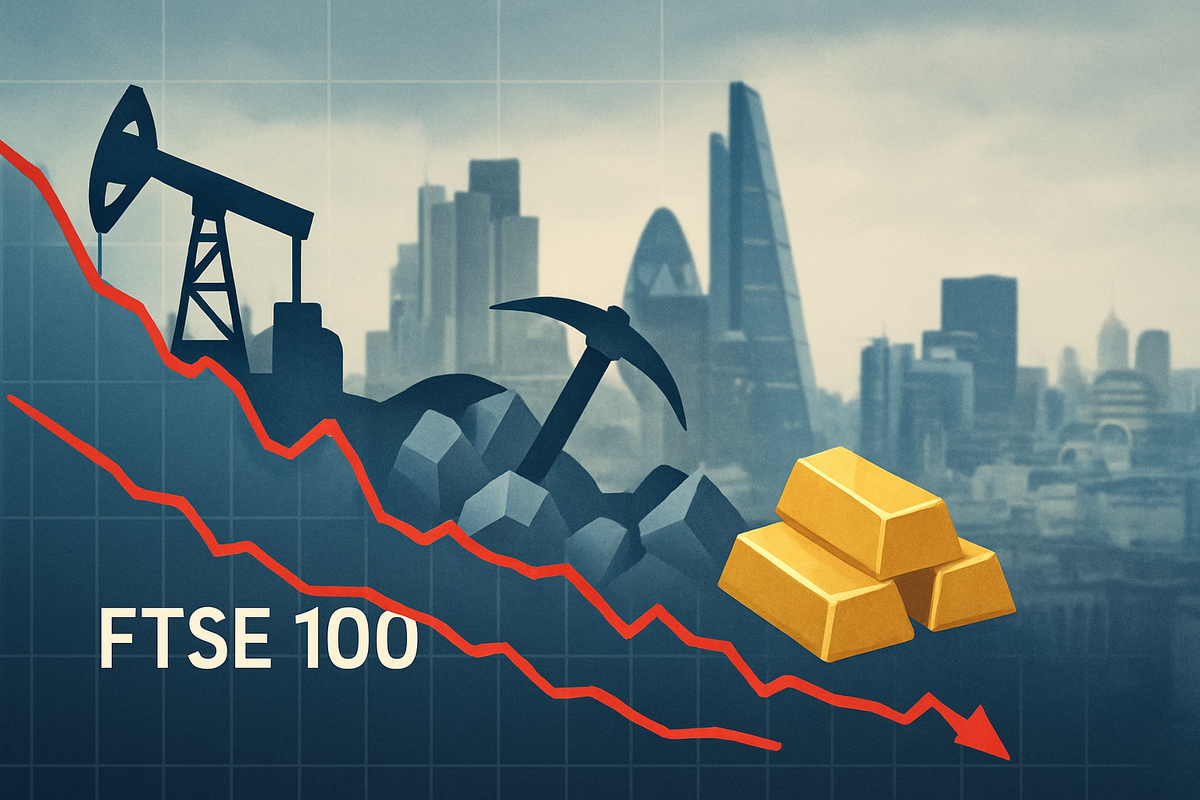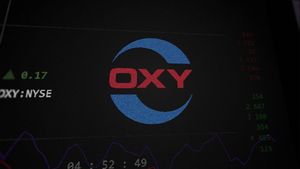
London's benchmark FTSE 100 index experienced a slight retreat on October 2, 2025, closing down 0.23% at the end of a trading day that saw it touch new record highs before succumbing to a complex mix of domestic and international pressures. This modest decline, which broke a four-day rally, has immediately cast a spotlight on the UK's heavily commodity-exposed sectors, revealing a mixed bag of fortunes and signaling potential shifts for some of the market's most influential players. The dip, while minor, prompts a closer examination of underlying economic currents and their specific implications for companies whose fates are inextricably linked to global resource prices.
The immediate implications of this downturn are particularly pertinent for the diverse array of public companies operating within the energy, mining, and precious metals spheres. While the overall market sentiment remains cautiously optimistic, buoyed by robust economic data from the US and Eurozone, the FTSE 100's performance on this day underscored a growing divergence within its ranks. Investors are now keenly assessing which sectors and individual companies are best positioned to navigate a landscape shaped by fluctuating commodity prices, geopolitical tensions, and evolving regulatory environments.
Detailed Market Movements and Contributing Factors
October 2, 2025, marked a nuanced trading session for the FTSE 100, which, despite an earlier surge to a new record high, ultimately closed 0.23% lower, ending a period of sustained growth. This slight retraction was not uniform across the board but rather a result of sector-specific pressures and broader economic concerns. The energy sector, a significant component of the index, notably declined by 0.6%, with major oil and gas producers like BP (LSE: BP) and Shell (LSE: SHEL) seeing their shares drop by nearly 1%. This was primarily attributed to crude oil prices extending their slide for a fourth consecutive day, with Brent crude trading around $64.42 a barrel amidst oversupply concerns. A July 2025 report had already painted a challenging picture for the sector, forecasting a substantial 37% contraction in first-half 2025 earnings for FTSE 100 energy companies.
The mining sector also presented a mixed performance. While some industrial metals, such as copper, registered moderate gains on the back of stronger demand signals from Asia, not all mining entities benefited. Fresnillo (LSE: FRES), a prominent precious metals miner, was listed among the day's biggest fallers on the FTSE 100. This highlights the varied sensitivities within the sector, with the broader Basic Materials sector projected to experience a 21% drop in H1 2025 earnings. Conversely, the precious metals market saw gold surge near record highs, trading close to $3,900 per ounce, driven by increased safe-haven demand amidst US fiscal risks and the potential for an extended government shutdown.
Beyond the commodity sectors, several other factors contributed to the FTSE 100's decline. Losses in healthcare stocks, which eased 0.3% after an 8.7% surge the previous day (following optimism from a Pfizer deal), and a significant downturn in industrial support services also weighed on the index. Experian (LSE: EXPN), the credit data company, saw its shares fall notably after FICO announced a direct-to-reseller licensing model for its credit score algorithm, a move that could dent Experian's earnings by 10-15%. A strengthening British pound also exerted pressure on export-heavy FTSE 100 constituents, offsetting gains in domestically focused sectors. The ongoing US government shutdown further fueled investor caution and delayed crucial US jobs data, adding uncertainty to the economic outlook and potential Federal Reserve interest rate decisions. Despite these headwinds, some positive corporate news tempered the overall decline, with Tesco (LSE: TSCO) shares climbing after the supermarket giant raised its annual profit outlook, and financial companies like 3i Group (LSE: III) and ICG (LSE: ICG) showing strength. Construction sector firm Morgan Sindall (LSE: MGNS) also surged to record highs after announcing its financial year 2025 results would be "significantly" ahead of expectations.
Companies at the Forefront: Winners and Losers
The FTSE 100's recent movements, particularly the slight dip on October 2, 2025, have created a distinct bifurcation among UK public companies, especially those with significant exposure to commodities. On one side, companies heavily reliant on crude oil prices, such as the energy giants BP (LSE: BP) and Shell (LSE: SHEL), are facing headwinds. Their share prices saw declines of nearly 1% as Brent crude continued its multi-day slide, underscoring the vulnerability of their earnings to global supply and demand dynamics. With a projected 37% contraction in the Energy sector's first-half 2025 earnings for FTSE 100 companies, these firms are under pressure to demonstrate resilience and strategic foresight in a volatile oil market. Their ability to manage operational costs, diversify energy portfolios, and adapt to evolving energy policies will be crucial in mitigating further losses.
Similarly, within the broader mining sector, the performance is uneven. While some industrial metal producers might benefit from specific demand signals, companies like Fresnillo (LSE: FRES), a major silver and gold miner, found themselves among the day's biggest fallers. This indicates that even within commodity sub-sectors, individual company performance is highly dependent on specific metal prices and operational efficiencies. The Basic Materials sector, which includes many miners, is forecast to see a 21% drop in H1 2025 earnings, suggesting a challenging environment for many players. Companies in this space will need to focus on cost control, high-grade asset development, and hedging strategies to protect against commodity price volatility.
Conversely, the flight to safety evident in the surging gold prices (near $3,900 per ounce) could indirectly benefit companies with significant gold mining operations or those holding substantial gold reserves, even if they are not exclusively precious metal miners. While specific direct beneficiaries on the FTSE 100 from gold's rise were not explicitly highlighted as gaining on October 2, the trend suggests a potential tailwind for companies that can capitalize on sustained high gold prices. Furthermore, companies with strong domestic focus or those in sectors demonstrating resilience against global commodity fluctuations, such as Tesco (LSE: TSCO) in retail, and financial entities like 3i Group (LSE: III) and ICG (LSE: ICG), showed strength, illustrating a market preference for stability and strong corporate guidance in uncertain times. This divergence suggests that investors are increasingly looking beyond traditional commodity plays towards companies with robust fundamentals and clear growth trajectories, irrespective of broader market sentiment in resource-heavy sectors.
Wider Significance: Navigating a Shifting Global Landscape
The modest dip in the FTSE 100 on October 2, 2025, while statistically minor, reverberates against a backdrop of significant broader industry trends that are fundamentally reshaping the operational landscape for commodity-exposed sectors. A prevailing trend is the acute commodity price volatility. The energy sector's decline, for instance, is a direct consequence of crude oil prices extending their slide, driven by concerns of oversupply and projected future weakness. The US Energy Information Administration (EIA) forecasts Brent crude potentially averaging $59 per barrel in Q4 2025, possibly dipping to $50 in early 2026, largely due to anticipated increases in OPEC+ output and record US crude production. This sustained downward pressure on oil prices signals not only potential profitability challenges for giants like BP (LSE: BP) and Shell (LSE: SHEL) but also reflects broader concerns about a weakening global economy.
Within the metals and mining space, the picture is more complex. While gold has surged to near-record highs, propelled by safe-haven demand amidst US fiscal risks, industrial metals face a mixed outlook. Persistent shortages of critical minerals like rare earths, copper, and polysilicon continue to strain supply chains for some industries, yet weak demand from key markets, particularly China, has weighed on prices for other industrial metals. However, the energy transition is expected to drive strong, sustained demand for critical minerals like copper, creating a strategic pivot point for mining companies. The overall sentiment for Q4 2025 anticipates a general softening of commodity prices due to a projected global economic slowdown, with commodity price risk ranking as a significant global concern expected to climb further by 2028 due to strained supply chains, geopolitical tensions, and climate disruption.
These commodity-specific dynamics are intertwined with a projected global economic slowdown and evolving central bank policies. While the Federal Reserve delivered its first rate cut of 2025 in September, with expectations of further gradual easing, the implications are two-fold. Lower interest rates could weaken the US dollar, potentially benefiting commodity prices, but if these cuts are a reaction to a looming recession, the overall demand for commodities could suffer. Furthermore, geopolitical events and escalating trade tensions continue to amplify market volatility. Conflicts affecting major energy-producing regions have contributed to rising inflation expectations and a substantial increase in gold prices. The ongoing US government shutdown on October 2, 2025, also added to investor caution, underscoring how political instability can disrupt market confidence and economic data releases. Tariffs and trade protectionist policies, if they surge, could severely disrupt global trade and potentially induce a policy-driven recession, directly impacting commodity flows and pricing.
The economic influence of China remains a critical factor. Despite signs of stagnation and deflation risks, China is still a primary driver of global oil demand and a significant consumer of industrial metals. While its slower economic momentum has tempered growth, signs of strength in China's manufacturing PMI since July 2025, coupled with expected fiscal stimulus, could provide some support for industrial commodity demand. These broader trends create significant ripple effects across the market. Competitors with stronger balance sheets and diversified supply chains may gain market share, leading to consolidation within commodity sectors. Partners, including suppliers and financial institutions, face increased risks; suppliers could see reduced orders, and banks providing funding to commodity firms may face higher credit risk. The volatile environment is also driving increased demand for working capital and trade finance solutions, as firms seek agility in disrupted supply chains.
Regulatory and policy implications are also shaping the future. The UK Financial Conduct Authority (FCA) finalized new rules for trading commodity derivatives in February 2025, with full implementation by July 6, 2026, aiming to enhance market transparency and prevent abuse. The UK is also progressing with its own Carbon Border Adjustment Mechanism (CBAM), with legislation expected by Autumn 2025 and full implementation by 2027, which will impose carbon costs on imports and impact carbon-intensive businesses. Additionally, the UK government is set to publish a new Circular Economy strategy by Autumn 2025, focusing on sectors like transport and construction, which will increase demand for reverse logistics and sustainable practices. Historically, the FTSE 100 has demonstrated resilience, recovering from major shocks such as the 2008 Global Financial Crisis or the 1987 "Black Monday." While the 0.23% decline on October 2, 2025, is a minor fluctuation compared to these events, the underlying themes of commodity price slumps, geopolitical uncertainty, and China's economic influence are recurring factors that have historically shaped the index's performance and recovery trajectories.
What Comes Next: Navigating Volatility and Strategic Shifts
The slight dip in the FTSE 100 on October 2, 2025, coupled with the broader trends affecting commodity-exposed sectors, signals a period of continued volatility and strategic re-evaluation for UK public companies. In the short-term, investors should anticipate ongoing fluctuations in commodity prices, particularly crude oil, as global supply-demand dynamics and geopolitical developments continue to unfold. The projected softening of overall commodity prices in Q4 2025 due to a global economic slowdown will likely keep pressure on energy and some industrial metals producers. Companies like BP (LSE: BP) and Shell (LSE: SHEL) will be closely watched for their quarterly earnings reports and any updates on production targets or divestment strategies aimed at shoring up profitability in a lower-price environment. The resilience of gold prices, driven by safe-haven demand, might offer some stability for diversified miners, but this could be offset by weakness in other metals.
Long-term possibilities point towards a more profound transformation within commodity sectors. The energy transition will continue to be a dominant force, driving strategic pivots towards "future-proof" commodities such as critical minerals essential for electric vehicles and renewable energy infrastructure. Mining companies that can adapt their portfolios to focus on these in-demand materials, while divesting from carbon-intensive assets, are likely to emerge as long-term winners. Conversely, companies heavily invested in traditional fossil fuels face persistent pressure to decarbonize, diversify, or risk becoming stranded assets. The UK's Carbon Border Adjustment Mechanism (CBAM) and the new Circular Economy strategy will accelerate this shift, demanding innovative approaches to supply chains, waste management, and sustainable production.
Strategic pivots or adaptations required will be multifaceted. Energy companies may accelerate investments in renewables, carbon capture technologies, and hydrogen, seeking to transform into broader energy solutions providers. Mining firms will need to enhance operational efficiencies, explore new extraction methods for critical minerals, and navigate increasingly complex environmental and social governance (ESG) expectations. For all commodity-exposed entities, robust hedging strategies will be crucial to mitigate price volatility, alongside a keen focus on supply chain resilience in the face of geopolitical disruptions and climate change impacts. The demand for sophisticated working capital and trade finance solutions is expected to grow as firms seek to maintain agility in this uncertain environment.
Market opportunities or challenges that may emerge include potential consolidation within struggling sub-sectors, where stronger players acquire distressed assets. Innovation in sustainable technologies and circular economy solutions will present new avenues for growth. However, challenges will include navigating a fragmented global trade landscape, managing increased regulatory scrutiny, and attracting capital in a market that is increasingly prioritizing ESG factors. The interplay between central bank monetary policies – particularly interest rate cuts – and their impact on global liquidity and the US dollar will also create both opportunities (e.g., cheaper financing) and challenges (e.g., if cuts signal deeper economic woes). Overall, the market will reward companies that demonstrate adaptability, strategic foresight, and a clear path to sustainable value creation amidst these evolving dynamics.
Comprehensive Wrap-Up: A Market in Transition
The FTSE 100's minor decline on October 2, 2025, though seemingly insignificant, serves as a poignant barometer for a market undergoing substantial transformation, particularly within its commodity-exposed sectors. The key takeaways from this event and the broader research underscore a period of heightened volatility driven by a confluence of global economic slowdown concerns, persistent geopolitical risks, and dynamic shifts in commodity supply-demand fundamentals. While gold's safe-haven appeal soared, crude oil's continued slide highlighted the vulnerability of energy giants, and the mixed performance of industrial metals reflected nuanced demand signals. The market is clearly differentiating between companies based on their exposure to these varied forces and their strategic readiness.
Moving forward, the market is likely to remain characterized by cautious optimism tempered by underlying uncertainties. The projected softening of overall commodity prices in the near term suggests that profitability for resource-heavy companies will face headwinds, necessitating stringent cost management and strategic portfolio adjustments. However, the long-term imperative of the energy transition will continue to shape investment flows, favoring companies positioned to capitalize on the growing demand for critical minerals and renewable energy solutions. Regulatory changes, such as the UK's new commodity derivatives regime and the impending Carbon Border Adjustment Mechanism, will further embed environmental and transparency considerations into operational and trading strategies.
Final thoughts on significance and lasting impact point to an era where resilience, adaptability, and a proactive approach to sustainability will be paramount. Companies that can effectively navigate commodity price swings, mitigate geopolitical risks, and align their business models with global decarbonization efforts are best placed for sustained success. The slight dip in the FTSE 100 is not a crisis, but rather a strong signal that the market is recalibrating, demanding greater strategic clarity and operational agility from its constituents.
What investors should watch for in coming months includes the trajectory of crude oil prices and any coordinated actions from OPEC+, as well as demand indicators from China for industrial metals. Central bank communications regarding interest rates will be crucial, as their decisions will influence global liquidity and economic growth prospects. Furthermore, corporate earnings reports from major commodity players will offer insights into their ability to manage costs and adapt to the evolving environment. Finally, progress on UK and international environmental policies and regulations will provide a roadmap for the long-term strategic direction of commodity-exposed companies. This content is intended for informational purposes only and is not financial advice







